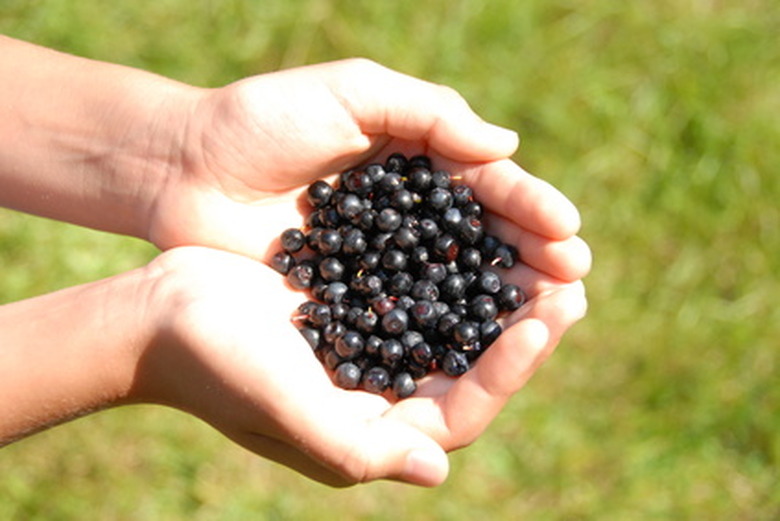How To Grow Huckleberries In Minnesota
Things Needed
- Huckleberry seeds (from wild Minnesota plants)
- 4-inch pots
- Peat moss-based potting mix (with 25 to 50 percent sand or perlite)
- Clean sand
- Spray bottle
- Florescent grow lights
- 10-15-10 or 15-30-15 fertilizer
- 50-percent shade cloth
- Sawdust or bark
- 10-10-10 fertilizer
- Spade
Western huckleberries are planted for their flavor, which advocates claim is superior to the taste of the blueberry. Berries from these woody perennial shrubs have been harvested from the wild for centuries, but western huckleberries have never been domesticated. Though the black huckleberry is native to the northwestern U.S., outcroppings do appear in Minnesota. And seeds from native plants may be planted in Minnesota gardens. But with the state's cold winters, seedlings need indoor protection during their first two winters. Huckleberry plants will begin bearing fruit three to five years after planting in Minnesota.
Starting Huckleberry Plants
Step 1
Fill pots with moistened potting soil in early January. Firm the soil to create a level surface and put three to four seeds in each pot. Sprinkle 1/8 inch sand over the seeds.
- Western huckleberries are planted for their flavor, which advocates claim is superior to the taste of the blueberry.
- Huckleberry plants will begin bearing fruit three to five years after planting in Minnesota.
Step 2
Place the pots in a location where the daytime temperature is between 70 and 80 degrees F and night time temperature is between 50 and 60 degrees F. Mist as frequently as needed to keep the soil moist but not soaked.
Step 3
Position huckleberry seedlings under florescent lights once they emerge, which should be within four to eight weeks. Keep the lights on for 12 to 16 hours per day, and keep the plants 2 to 4 inches below the light source while maintaining the day and nighttime temperatures given in Step 2.
Step 4
Water huckleberry plants daily or twice daily to prevent the potting soil from drying out.
Step 5
Thin seedlings by removing all but the largest plant per pot once seedlings reach about 1/2 inch tall.
Step 6
Fertilize seedlings with either 10-15-10 or 15-30-15 fertilizer about every two weeks through mid-August, following directions on the fertilizer package. Water huckleberries heavily every two to three weeks to rinse out excessive salts.
- Place the pots in a location where the daytime temperature is between 70 and 80 degrees F and night time temperature is between 50 and 60 degrees F. Mist as frequently as needed to keep the soil moist but not soaked.
- Keep the lights on for 12 to 16 hours per day, and keep the plants 2 to 4 inches below the light source while maintaining the day and nighttime temperatures given in Step 2.
Step 7
Move potted huckleberry plants outdoors in mid-August to help them acclimate to the coming dormancy period. Place plants under 50 percent shade cloth or slats. The huckleberry leaves will turn bright red, which is a normal part of acclimation.
Step 8
Put plants in winter storage once the nighttime temperature drops to about 30 degrees F. Store them in a place where the temperature remains between 30 and 35 degrees F. Light is not necessary for dormant huckleberries. Water plants as needed to prevent soil from drying out.
Step 9
Move potted huckleberries outdoors when spring comes, in partial shade to full sun. Resume watering and fertilizing schedule as described for the first year. In the second winter, store huckleberry plants as you did for the first.
- Move potted huckleberry plants outdoors in mid-August to help them acclimate to the coming dormancy period.
Huckleberries in Their Permanent Home
Step 1
Prepare the huckleberry bed a year prior to outdoor planting. Choose a site with similar soil conditions to the location where the Minnesota seed berries were harvested and spread a layer of sawdust or bark 6 inches deep. Till it in while adding one pound of 10-10-10 fertilizer per cubic foot of sawdust or bark.
Step 2
Plant huckleberries in the ground in either spring or fall, when they reach about 6 inches in height. Dig holes for the plants that are just deep enough to cover the potting soil that they were growing in. Place plants about 3 feet apart in rows that are about 9 feet apart.
Step 3
Water the plants immediately after planting. Mulch around each plant with about 4 inches of fine bark or sawdust. Water huckleberries regularly. Water the soil instead of wetting the leaves and fruit. Keep the soil evenly moist but not waterlogged.
- Prepare the huckleberry bed a year prior to outdoor planting.
- Water the soil instead of wetting the leaves and fruit.
Step 4
Fertilize plants each spring with either manure or a granular fertilizer.
Step 5
Pull weeds by hand as needed, keeping in mind that huckleberries do not compete well with weeds. Use mulch to help keep weed growth at bay.
Tip
If huckleberry leaves turn red during the spring or summer even though plants are receiving adequate water, a nitrogen deficiency may be to blame.
Warning
Do not prune young huckleberry plants. Light pruning is permissible, if needed, to provide air movement and light penetration for densely growing older plants.
